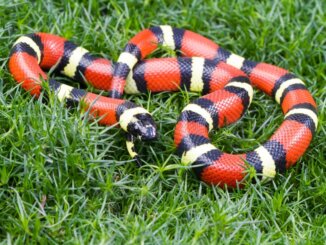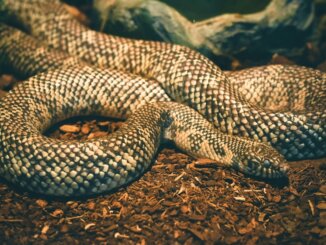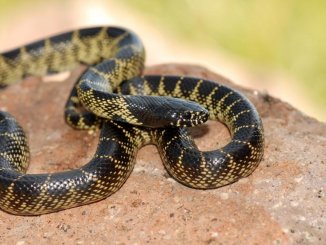The eyelash viper is native to Central and Southern America. This snake has a triangular head and an enlarged supraciliary that looks like eyelashes. The eyelash viper is a small species of snake with a yellow, gold, red, or brown coloration.
Eyelash vipers are easy to care for if you have the right training. These snakes are hard to feed, but keepers can follow a feeding schedule to overcome this hurdle.
Eyelash Viper Overview
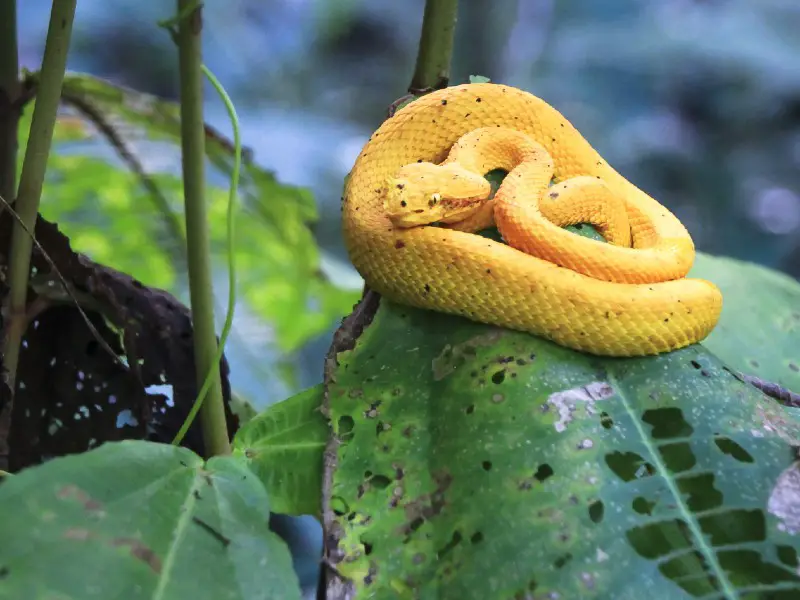
| Category | Rating |
| Common Names: | Eyelash mountain viper, Horned palm viper, Schlegel’s viper, eyelash palm-pit viper |
| Scientific Name: | Bothriechis schlegelii |
| Natural Habitat: | Densely vegetated sea-level forests |
| Adult Size: | 22–36 inches |
| Average Lifespan: | Up to 10 years |
| Diet: | Carnivore |
| Housing: | Branches, leaves, shade |
| Experience Level: | Beginner |
Origin
The eyelash viper (Bothriechis schlegelii) is native to Central and South America. This snake lives in densely wooden sea-level forests. The eyelash viper inhibits vine tangles, shrubbery, and low trees.
Eyelash vipers aren’t endangered, and they are easy to spot in their natural habitat. However, eyelash vipers are at risk of habitat loss due to deforestation and urbanization.
Appearance and Behavior
Eyelash vipers come in many color forms. They’re either yellow, brown, red, or gold with a mottled underbelly. Their base colors often display small black spots. Their heads are wide and triangular, and they have elongated supraciliary.
Male and female eyelash vipers look similar. Females are larger than males. Their size difference is the biggest difference between males and females.
Size and Lifespan
Female eyelash vipers grow up to 36 inches long. Males will grow to 34 inches long and are almost always smaller and slimmer than females.
These snakes live for up to 10 years in the wild and up to 16 years in captivity. This is because captive snakes get immediate medical treatment when they are sick, and live in controlled environments without external threats.
Temperament
Eyelash vipers will strike if they feel harassed, but this species is generally solitary and peaceful. Eyelash vipers flick their tongues continuously. This behavior isn’t threatening and allows snakes to taste chemicals in the air.
Adult eyelash vipers can share an enclosure because snakes of this species aren’t known to show aggression and cannibalism to one another. Snakes sharing an enclosure need plenty of space to prevent stress. Although eyelash vipers can coexist happily, you should keep them in separate enclosures to avoid conflict.
Humans can handle eyelash vipers with caution. These snakes will bite when they feel threatened, so only experienced snake keepers should attempt to handle eyelash vipers.
Housing Eyelash Vipers
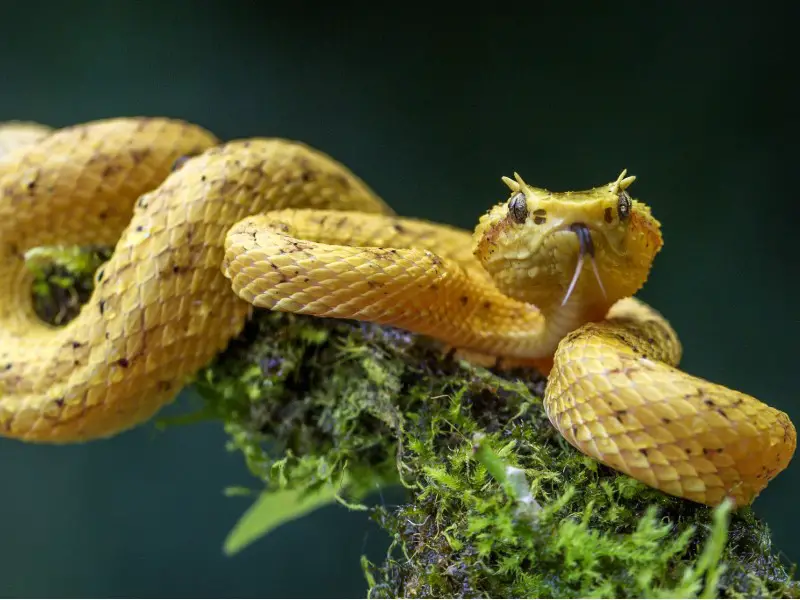
Eyelash vipers inhabit densely-wooded areas and streamside vegetation. They’re also found in sea-level forests and other moist lowland areas with rich vegetation. An eyelash viper’s vivarium should replicate its natural habitat as closely as possible.
Vivariums are suitable enclosures for eyelash vipers. DIY vivariums are fine to use, but it’s better to invest in a professional vivarium from a reputable pet store for health and safety reasons.
Enclosure size
Eyelash vipers need plenty of space to move around in. These snakes are small and slim but should be kept in a vivarium that is at least 16 inches wide and 24 inches tall.
Snake keepers should provide their snakes with enough space to climb in the enclosure and plenty of dedicated hiding spots. Eyelash vipers do well in 75-gallon lizard lounges. However, large enclosures are costly and hard to decorate.
Lighting
Eyelash vipers live in highly vegetated locations in the wild. Their natural habitat doesn’t receive a lot of direct sunlight, which is why it’s vital to get the enclosure lighting correct.
These snakes are nocturnal, but they don’t hide during daylight hours like many other snake species. Maintaining a natural day to night light cycle is important to maintain your eyelash viper’s circadian rhythm.
Lighting contributes to the temperature levels in the vivarium. Full-spectrum light bulbs help keep the heat levels in the vivarium at appropriate levels.
Keep UVB lights away from the enclosure. UVB is unnecessary and will not benefit the eyelash viper.
Some snake keepers argue that using one UVB lamp in a snake enclosure will enhance the snake’s coloration and activity. However, this is debatable and not recommended as it could cause the snake serious damage.
Temperature and Humidity
Make sure the enclosure temperature stays between 79 degrees and 82 degrees Fahrenheit. The designated basking area should have a constant temperature of 85 degrees Fahrenheit.
Ceramic heat emitters are great tools that help maintain the enclosure temperature. You should keep ceramic heat emitters away from designated hiding spots and shaded areas.
Eyelash vipers adapt well to their surroundings and can endure varying humidity levels. These snakes do well in 60 to 70% humidity. You should spray the enclosure with water twice daily to ensure humidity levels in the enclosure stay constant.
Snakes shed their skin three or four times each year. Juvenile eyelash vipers will shed their skin more than three times every year due to their fast growth rate. Eyelash vipers will also shed their skin more frequently if they have a skin condition. You should keep humidity levels high when snakes shed their skin.
Substrate and Decoration
Cypress mulch is an appropriate substrate for eyelash viper enclosures. Cypress mulch holds moisture without producing mold or fungus. Lining the enclosure with a substrate that holds moisture will keep the humidity level in the vivarium high.
Decorate the enclosure with small branches and delicate foliage. Eyelash vipers are small and prefer to wrap themselves around flexible, slim branches.
You should decorate shaded areas with large leaves. Pothos are snake-safe plants suitable for eyelash viper enclosures. Make sure any branches and foliage are secure and stable in the enclosure.
Cleaning
The best way to clean an eyelash viper enclosure is with warm water and dish soap. You should sanitize decorations and accessories with 10% bleach once every month. Remember to rinse off the bleach with hot water.
Here are step-by-step instructions for cleaning an eyelash viper tank:
- Move the snake to a temporary container.
- Turn off the lights and remove them from the vivarium.
- Remove the decorations and clean them with 10% bleach. Rinse the bleach off with hot water before placing the decorations back onto the enclosure.
- Remove and discard the old substrate.
- Wash the vivarium with warm soapy water and leave to dry.
- Add new substrate and place the decorations and plants back into the vivarium.
Eyelash Viper Care
Eyelash vipers are easy to care for. These snakes are suitable for beginner snake keepers. However, eyelash vipers are hard to feed, so extra care should be taken during mealtimes. People with previous snake care experience will find caring for these snakes easy and enjoyable. Eyelash vipers are also suitable for beginners seeking a challenge.
Food and Water
Eyelash vipers eat mice in captivity. You should feed eyelash vipers twice weekly. These snakes can become overweight, so refrain from overfeeding them. Juvenile eyelash vipers should eat less than adult snakes. Feed juveniles once weekly to help them maintain a healthy weight.
Provide your eyelash viper with an elevated water bowl. Place the bowl under branches and amongst foliage in the tank. You should ensure the bowl is always full and mist the enclosure with water daily.
Eyelash vipers are nocturnal hunters. These snakes will sit and wait for their prey to pass before they strike. Ensure snakes in captivity continue to display these behaviors by providing them with live food.
Handling
Eyelash vipers are peaceful snakes, but they don’t like to be handled. You should handle eyelash vipers using a hook or with extreme care, as they bite when they feel threatened.
Only experienced snake keepers should handle an eyelash viper. An inexperienced handler will often hold the snake incorrectly, which can cause the snake extreme stress. This makes the viper more likely to bite.
Common Health Issues
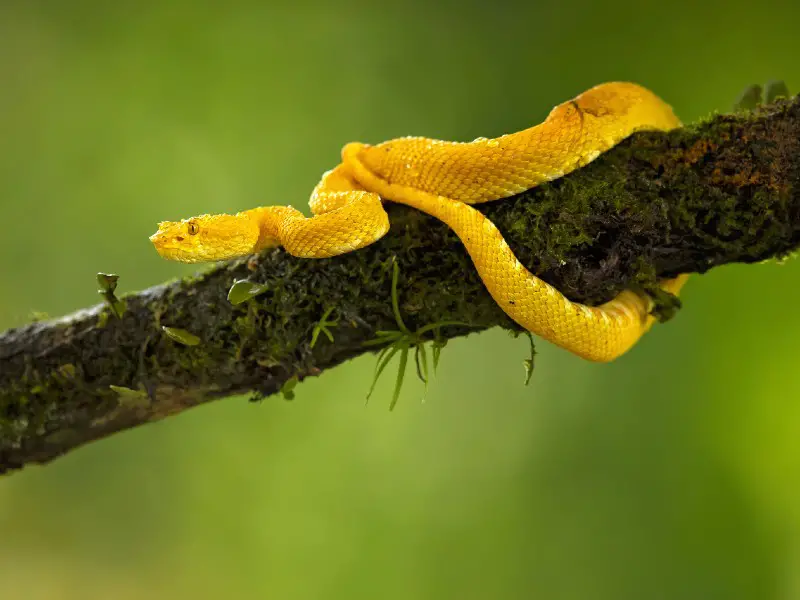
Eyelash vipers can catch common diseases that affect snakes in captivity. Failure to spot diseases and infections could lead to irreversible health problems. Here are the most common problems to look out for and how to treat them:
- Mouth rot — caused by poor nutrition, inappropriate enclosure conditions, overcrowding, and mouth injury. Antiseptic oral cleaners and antibiotics treat mouth rot within a week.
- Internal and external parasites — worms, ticks, and mites are common eyelash viper snake issues. Mid-body swelling indicates internal infections. Ticks and mites are easy to spot. These conditions will lead to anemia and other related health conditions if left untreated. Treat parasite conditions with medication.
- Skin infection — blisters, inflammation, and unevenness points to a skin infection. Improve ventilation in the vivarium to treat a skin issue.
- Respiratory infection — snakes with respiratory issues lose their appetites, have nasal and oral discharge, and are lethargic. Treat respiratory infections with essential oils.
Breeding
Breed eyelash vipers during late winter to early spring. Breeding these snakes is easy in captivity under the right conditions.
Males dance around one another in a “dance of the adders.” Two males will adopt an upright stance and push one another until one of the snakes falls to the ground. Whoever remains standing wins the right to mate.
Pregnant females display large, swollen abdomens. Gestation lasts up to six months, and the snakes have live births. Eyelash pit vipers will wait until they are alone and undisturbed to give birth.
Place a pair of eyelash vipers in a cage during the breeding season and wait for them to mate. Ensure the conditions in the vivarium are exact and wait for the snakes to mate. Eyelash vipers will breed once or twice every year.
Choosing and Buying an Eyelash Viper
Eyelash vipers cost between $100 and $250 per snake. You must buy these snakes from reputable breeders. Eyelash vipers aren’t readily available in pet shots, and you will struggle to find these snakes online.
Keeping an eyelash viper as a pet is legal, but catching a wild eyelash viper is illegal in many countries. Catching this snake for resale could land you in legal trouble.
Shop around for the healthiest eyelash viper before making a purchase. Don’t buy the snake if it is lethargic, displays skin blisters, or has saliva or foam coming out of its mouth. These signs indicate that the snake is sick. Make sure you look for a healthy snake before introducing it into your home.

